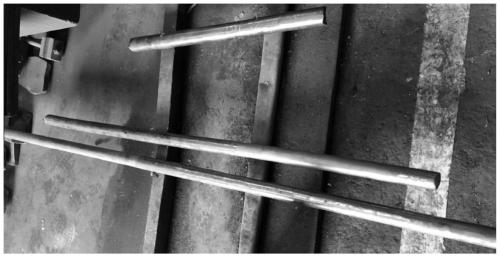Processing and forming process of high-strength nickel-based high-temperature alloy bar
A high-temperature alloy, processing and forming technology, applied in the field of material processing, can solve the problems of increasing the red hardness of the alloy and the influence of the processing performance of the alloy, and achieve the effect of improving the structure of the alloy.
- Summary
- Abstract
- Description
- Claims
- Application Information
AI Technical Summary
Problems solved by technology
Method used
Image
Examples
Embodiment 1
[0041]According to the alloy composition, the content of each element meets the following requirements in terms of mass percentage: Cr: 16%, Co: 20%, Al: 3.9%, Ti: 1.1%, Nb: 1.5%, W: 6.8%, Si: 0.15 %, Mn: 0.25%, C: 0.07%, and the balance is Ni. The alloy is smelted in an induction electric arc furnace with a magnesium oxide basic furnace lining. The furnace is washed with pure nickel before smelting, and the alloy raw material is shot blasted before being added. During alloy melting, the vacuum degree is controlled within the range of 0.35Pa. After Cr, Co, Ni, W, Nb and other elements are completely melted, it is refined for 40 minutes, and high-purity argon is introduced before adding Al, Ti, and C for protection. During the smelting process, coke and Ni-Mg are used for secondary deoxidation, and the content of P and S in the alloy is not higher than 0.03% after the smelting is completed.
[0042] The alloy ingot was heated at a rate of 10°C / min to 1000°C for 0.5 hours, then...
Embodiment 2
[0045] According to the alloy composition, the content of each element meets the following requirements in terms of mass percentage: Cr: 20%, Co: 15%, Al: 3.4%, Ti: 1.8%, Nb: 0.5%, W: 6.7%, Si: 0.10 %, Mn: 0.15%, C: 0.07%, and the balance is Ni. The alloy is smelted in an induction electric arc furnace with a magnesium oxide basic furnace lining. The furnace is washed with pure nickel before smelting, and the alloy raw material is shot blasted before being added. During alloy melting, the vacuum degree is controlled within the range of 0.35Pa. After Cr, Co, Ni, W, Nb and other elements are completely melted, it is refined for 40 minutes, and high-purity argon is introduced before adding Al, Ti, and C for protection. During the smelting process, coke and Ni-Mg are used for secondary deoxidation, and the content of P and S in the alloy is not higher than 0.03% after the smelting is completed.
[0046] The alloy ingot was heated at a rate of 10°C / min to 1000°C for 0.5 hours, the...
Embodiment 3
[0049] According to the alloy composition, the content of each element meets the following requirements in terms of mass percentage: Cr: 23%, Co: 15%, Al: 2.5%, Ti: 2.4%, Nb: 0.5%, W: 3.0%, Si: 0.2 %, Mn: 0.35%, C: 0.06%, and the balance is Ni. The alloy is smelted in an induction electric arc furnace with a magnesium oxide basic furnace lining. The furnace is washed with pure nickel before smelting, and the alloy raw material is shot blasted before being added. During alloy melting, the vacuum degree is controlled within the range of 0.35Pa. After Cr, Co, Ni, W, Nb and other elements are completely melted, it is refined for 40 minutes, and high-purity argon is introduced before adding Al, Ti, and C for protection. During the smelting process, coke and Ni-Mg are used for secondary deoxidation, and the content of P and S in the alloy is not higher than 0.03% after the smelting is completed.
[0050] Heat the alloy ingot at a rate of 10°C / min to 950°C and keep it warm for 0.5 h...
PUM
| Property | Measurement | Unit |
|---|---|---|
| Diameter | aaaaa | aaaaa |
Abstract
Description
Claims
Application Information
 Login to View More
Login to View More - R&D Engineer
- R&D Manager
- IP Professional
- Industry Leading Data Capabilities
- Powerful AI technology
- Patent DNA Extraction
Browse by: Latest US Patents, China's latest patents, Technical Efficacy Thesaurus, Application Domain, Technology Topic, Popular Technical Reports.
© 2024 PatSnap. All rights reserved.Legal|Privacy policy|Modern Slavery Act Transparency Statement|Sitemap|About US| Contact US: help@patsnap.com










